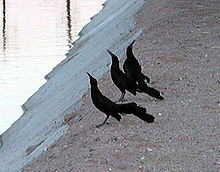Lek mating
Template:Otheruses2 A lek is a gathering of males, of certain animal species, for the purposes of competitive mating display. Leks assemble before and during the breeding season, on a daily basis. The same group of males meet at a traditional place and take up the same individual positions on an arena, each occupying and defending a small territory or court. Intermittently or continuously, they spar individually with their neighbors or put on extravagant visual or aural displays (mating "dances" or gymnastics, plumage displays, vocal challenges, etc.).

The term derives from the Swedish lek, a noun which typically denotes pleasurable and less rule-bound games and activities ("play", as by children). Specifically, the etymology of the word "lek" is from 1871 and means to engage in courtship displays (of certain animals); probably from the Swedish leka "to play".[3] A strict hierarchy accords the most desirable top-ranking males the most prestigious central territory, with ungraded and lesser aspirants ranged outside. Females come to these arenas in due course to be fertilized, and normally they make their way through to one or other of the dominants in the centre.
Lekking behavior
Two main types of lek are distinguished, classical leks and exploded leks. In classical leks, individuals gather within sight of each other to court and compete. Physical contest in these situations is frequent, and plays a major role in the mating rituals of certain shorebird and gamebird species. In Copadichromis eucinostomus, a type of fish, the males build sand castles. The lek member with the tallest mound of sand - almost a meter wide at the base - wins the females. These sandcastles take this ten centimeter (four inch) long animal two weeks to build. Peacocks also form leks to display their tails.[4]
Exploded leks rely on vocal signals. Male hammer-headed bats have a voice box that occupies more than half their body cavities; during breeding season, they gather for several hours at dawn and dusk to honk for females.[4] The most famous example of exploded leks is the "booming" call of the Kakapo, the males of which position themselves many kilometers apart from one another to signal to potential mates. Indeed, female kakapos seemed to often have considerable difficulty locating mates as the population declined on mainland New Zealand; this was a significant contributing factor to the insufficient reproduction rate which caused this species to go extinct outside human care for some years.
The lek paradox
Persistent female choice for particular male trait values should erode genetic variance in male traits and thereby remove the benefits of choice, yet choice persists. This is most obvious in lekking species where females gain no material benefits or parental care from males.[5] This paradox can be somewhat alleviated by the occurrence of mutations introducing potential differences, as well as the possibility that traits of interest have more or less favorable recessive alleles.
In a few species (peacocks and the black grouse), leks are composed of brothers and half-brothers. These species avoid this paradox because the lower-ranking males are passing on their genes through attracting mates for their brothers (larger leks attract more females). Peacocks recognize and will lek with their brothers, even if they have never met before. [4]
Lekking species
The term was originally used most commonly for Black Grouse (orrlek) and for Capercaillie (tjäderlek), and lekking behaviour is quite common in birds of this type, such as Sage Grouse, Prairie Chicken, and Sharp-tailed Grouse. However it is also shown by birds of other families, such as the Ruff, Great Snipe, Musk Ducks, Hermit hummingbirds, Manakins, birds of paradise, Screaming Pihas and the Kakapo, by some mammals such as the Uganda kob (a waterbuck) and the topi, and by some species of fish and even insects like the midge and the Ghost Moth. The rut of deer is also very similar. There is some dispute among ethologists as to whether the lekking behaviour shown by animals of widely different groups should really be treated as the same, and in particular whether similar selective pressures have led to their emergence.

References
- ^ Starr, Cecie (1992). Biology – the Unity and Diversity of Life, 6th Ed. Wadsworth Publishing Company. ISBN 0534165664.
{{cite book}}: Unknown parameter|coauthors=ignored (|author=suggested) (help) - ^ Hall, Edward T. (1966). The Hidden Dimension. Anchor Books. ISBN 0-385-08476-5.
- ^ Lek (definition) - Online Etymology Dictionary
- ^ a b c Judson, Olivia 2002. Dr. Tatiana's Sex Advice To All Creation. Metropolitan Books. ISBN 0-8050-6331-5.
- ^ Tomkins, Joseph L. "Genic capture and resolving the lek paradox." TRENDS in Ecology and Evolution. Vol.19 No.6 June 2004.
